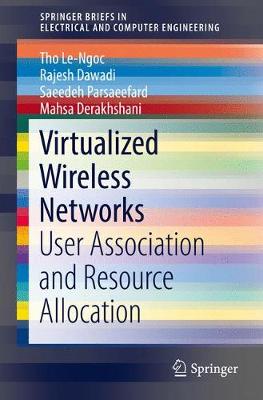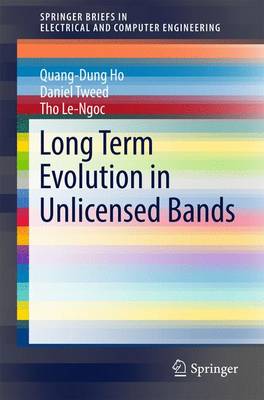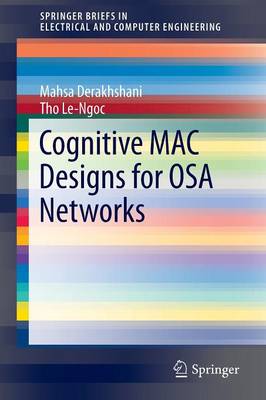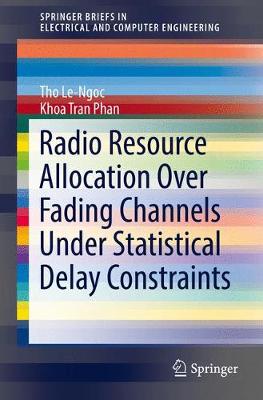SpringerBriefs in Electrical and Computer Engineering
4 total works
Virtualized Wireless Networks
by Tho Le-Ngoc, Rajesh Dawadi, Saeedeh Parsaeefard, and Mahsa Derakhshani
There have been recent advancements in wireless network technologies such as wireless virtualization to accommodate the exponential growth in demand, as well as to increase energy and infrastructure efficiencies. This SpringerBrief discusses the user-association and resource-allocation aspects in Virtualized Wireless Networks (VWNs) and highlights key technology innovations to meet their requirements. Various issues in practical implementation of VWNs are discussed along with potential techniques such as Massive MIMO, Cloud-Radio Access Network (C-RAN), and non-orthogonal multiple access (NOMA).
This SpringerBrief will target researchers and professionals working on current and next-generation wireless networks. The content is also valuable for advanced-level students interested in wireless communications and signal processing for communications.
Long Term Evolution in Unlicensed Bands
by Quang-Dung Ho, Daniel Tweed, and Tho Le-Ngoc
LTE using unlicensed frequency (U-LTE) is then introduced as the most promising solution, and discussed from various perspectives to unveil its benefits, challenges, and requirements for coexistence with the widely-deployed IEEE 802.11/Wi-Fi technology. Meeting these coexistence requirements is the most important factor for the acceptance of U-LTE, and the majority of this brief explores the big picture concerns and existing solutions related to coexistence-aware medium access protocols for background knowledge. A proposed network-aware adaptive listen-before-talk protocol is presented and evaluated.
Finally, the authors identify a number of open technical questions and potential research issues in U-LTE. This SpringerBrief is suitable for telecom engineers, researchers, and academic professionals with valuable knowledge and potential working or research directions when designing and developing medium access protocols for next generation wireless access networks.
Cognitive MAC Designs for OSA Networks
by Mahsa Derakhshani and Tho Le-Ngoc
This SpringerBrief presents recent advances in the cognitive MAC designs for opportunistic spectrum access (OSA) networks. It covers the basic MAC functionalities and MAC enhancements of IEEE 802.11. Later chapters discuss the existing MAC protocols for OSA and classify them based on characteristic features.
The authors provide new research in adaptive carrier sensing-based MAC designs tailored for OSA, which optimize spectrum utilization and ensure a peaceful coexistence of licensed and unlicensed systems. Analytically devised via optimization and game-theoretic approaches, these adaptive MAC designs are shown to effectively reduce collisions between both primary and secondary network users.
Researchers and professionals working in wireless communications and networks will find this content valuable. This brief is also a useful study guide for advanced-level students in computer science and electrical engineering.
Radio Resource Allocation Over Fading Channels Under Statistical Delay Constraints
by Tho Le-Ngoc and Khoa Tran Phan
This SpringerBrief presents radio resource allocation schemes for buffer-aided communications systems over fading channels under statistical delay constraints in terms of upper-bounded average delay or delay-outage probability.
This Brief starts by considering a source-destination communications link with data arriving at the source transmission buffer. The first scenario, the joint optimal data admission control and power allocation problem for throughput maximization is considered, where the source is assumed to have a maximum power and an average delay constraints. The second scenario, optimal power allocation problems for energy harvesting (EH) communications systems under average delay or delay-outage constraints are explored, where the EH source harvests random amounts of energy from renewable energy sources, and stores the harvested energy in a battery during data transmission. Online resource allocation algorithms are developed when the statistical knowledge of the random channel fading, data arrivals, EH processes governing the system dynamics is unknown a-priori.
This Brief continues with a source-relay-destination communications link with buffers available at both source and relay, as part of a multi-hop network. Optimal resource allocation schemes for this 3-node relaying system to maximize its effective capacity under a delay-outage constraint are proposed, with special emphasis on relay roles: Half-duplex (HD) or full-duplex (FD) relay operation. With HD relay, the adaptive link selection relaying problem jointly with both fixed and adaptive power allocation schemes is investigated. Within each transmission frame, either the source-relay link or the relay-destination link is selected to be active depending on the channel conditions. With FD relay under the presence of non-zero residual self-interference (SI).
This Brief also presents source and relay power allocation schemes for both cases of available knowledge of the channel state information at transmitter (CSIT): instantaneous or statistical. Professional and researchers working in this related field and advanced-level students in electrical or computer engineering will find the content valuable as a reference.



